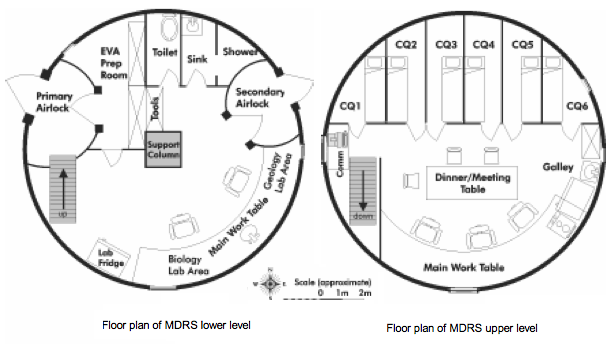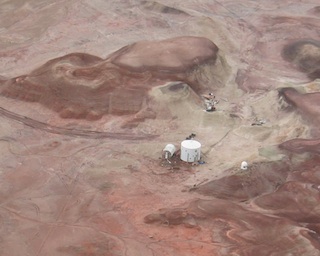<div id="kmnav2">
- [Overview]
- Upper Level
- Lower Level
- Airlocks
- Crew Quarters
- Greenhouse
- Engineering
- Observatory
Unknown macro: {html}
</div>

Features indicated on the picture
- Airlock door: Entry to a small room, where crew members wait while the room is 'pressurised'. At MDRS, this is simulated using a 5-minute time delay. There is a similar airlock called 'engineering' or secondary airlock on the opposite side.
- Greenhouse: Contains the water recycling system at the front and the glasshouse at the back.
- Satellite dish: Enables the communication via internet with the crew. The bandwidth is very restrictive.
- Observatory: Harbours a Celestron C-14 with
- [Rover]s: 4 individual rovers are provided to the crew: Viking, Opportunity I, Opportunity II and .... There is also a 'pressurised rover' (4WD) for longer trips or to be used in emergencies.
- Solar Panels - don't work
- Weather station - not sure if it works
it's on our website - Blah blah. history of hab - similar in size to a proposed Mars mission's habitat.
Since 2001, the Mars Desert Research Station (MDRS) enabled more than 100 crews of scientists, students, teachers and space enthousiasts to undertake Moon and Mars analogue field research activities. In addition to that, MDRS has also been used like a classroom to train crew members in the fundamentals of Moon and Mars analog ressearch operations.

Analogue Research Stations are laboratories for learning how to live and work on another planet. Each is a prototype of a habitat that will land humans on Mars and serve as their main base for months of exploration in the harsh Martian environment. Such a habitat represents a key element in current human Mars mission planing. Each Station's centerpiece is a cylindrical habitat, "The Hab," an 8-meter diameter, two-deck structure mounted on landing struts. Peripheral external structures, some inflatable, may be appended to the Hab as well.
Live Webcam
<img style="border: 1px solid;" id="webcam" src="http://www.freemars.org/mdrscam/outside/MDRS-astro-cam.jpg" name="webcam" width="320" height="240"/><br/>
Image refreshes in <b id="countDownText">0</b> seconds.<br/>
<script type="text/javascript">
<!--
var countDownInterval=180;
var countDownSecondsIncrement=1;
var countDownTime=countDownInterval;
function reloadImg(object) {
uniq = new Date();
uniq = "?"+uniq.getTime();
newImage = object.src;
index = newImage.indexOf("?", 0);
if (index > 0)
object.src = newImage+uniq;
}
function countDown() {
countDownTime=countDownTime-countDownSecondsIncrement;
if (countDownTime < 0)
document.all.countDownText.innerText = countDownTime;
setTimeout("countDown()", countDownSecondsIncrement * 1000);
}
document.all.countDownText.innerText = countDownTime; // Set initial time
setTimeout("countDown()", countDownSecondsIncrement * 1000);
// -->
</script>
Aerial View
View MDRS from the air.
Image courtesy of Doug Martin, Mars Society at Georgia Tech.
